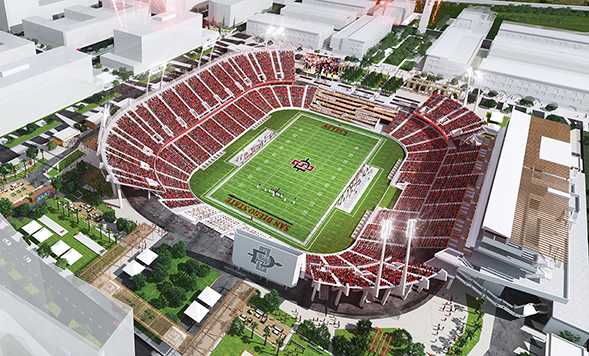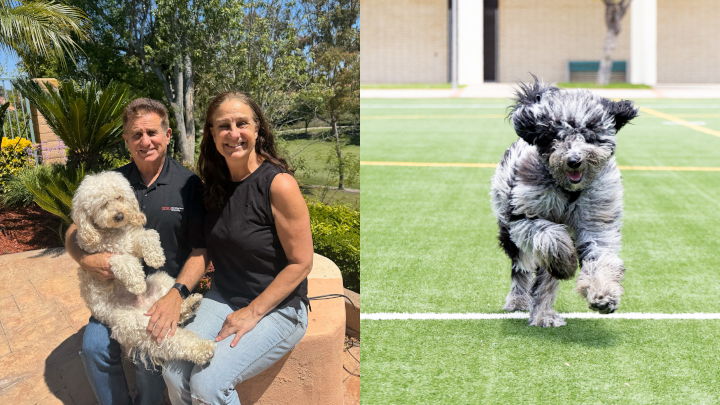A Stadium for San Diego
The proposed 35,000-seat venue is designed to host football, soccer and a variety of other events.

“We have the opportunity to build a right-sized, high-quality, multi-use stadium, one that San Diegans can utilize every day of the year.”
View the full SDSU Mission Valley site plan and architectural concepts at www.sdsu.edu/missionvalley.
This story appears in the spring 2018 issue of 360: The Magazine of San Diego State University.
There’s a gratifying sense of coming full circle in San Diego State University’s plans to build a multi-use sports stadium in Mission Valley.
The stadium is just one piece of SDSU’s comprehensive vision for a satellite campus in Mission Valley, but the significance of playing in a stadium of one’s own is not lost on Aztec loyalists.
“SDSU fans have long dreamed of the day we would return our football stadium to campus,” said John David Wicker, the university’s athletic director.
They’ve been dreaming for 50 years. In the late 1960s, SDSU moved into NCAA Division I and was forced to abandon Aztec Bowl as a playing field, though the campus icon was preserved and subsequently listed on the National Register of Historic Places.
While the Aztecs’ new home in Qualcomm Stadium (now SDCCU Stadium) accommodated larger numbers of Aztec fans, it “never really felt like home,” said Leon Parma (’51), Aztec Hall of Fame quarterback for the 1950 squad.
All events welcome
It would be a homecoming of sorts, then, if San Diego voters approve the November ballot initiative to sell SDSU the stadium site and adjoining acreage in Mission Valley. Construction of a new stadium will be part of the initial phase of development on the site.
University officials estimate the cost at $250 million for a 35,000-seat stadium at the northwest corner of the site to be financed with donor support, naming rights and sponsorships, long-term bonds, revenue from athletic events and rent from food, beverage and merchandise concessions.
“We would prefer a corporate sponsor for the stadium, as we have for Viejas Arena on campus, because this allows us to renew the sponsorship every few years and generate new income,” said Wicker.
The stadium would be a community resource, available to host collegiate football, professional and collegiate soccer, NCAA championship games, concerts and other events. Plans include the option to expand to 55,000 seats to accommodate professional football, should an NFL team return to San Diego.
“You name it, we’ll host it,” said Wicker. “We have the opportunity to build a right-sized, high-quality, multi-use stadium, one that San Diegans can utilize every day of the year.”
A chance to excel
Returning Aztec football to campus— exciting though it may be—is not the university’s primary reason for wanting the Mission Valley acreage. The expansion of SDSU’s campus to a second site in Mission Valley also expands higher education opportunities in San Diego, noted Brian Sipe (’70), former NFL MVP and SDSU quarterback, Aztec quarterbacks coach and Aztec Hall of Famer.
SDSU Mission Valley would accommodate new high-tech labs, innovation space and research facilities. The new campus would build SDSU’s capacity for public/private collaboration in fields such as cybersecurity, artificial intelligence, biomedical research, health diagnostics, environmental monitoring, engineering and communications technology.
A well-executed plan, modeled on successful campus expansions across the United States, would benefit SDSU and generate tax revenue for San Diego, said Wicker.
Georgia Tech’s Technology Square, for example, is a redeveloped district in midtown Atlanta with academic buildings, major corporate offices, collaborative spaces for public/private partnerships, incubators and commercial space.
“It’s a prime example of what we would like to do in Mission Valley,” said Wicker.
Uniquely San Diegan
JMI Sports and Kansas City–based Populous, the architectural lead for Petco Park, developed the stadium’s design plans. The blueprints call for premium seating and moveable loge boxes, a separate student section, a canopy roof for potential soccer competitions and “garden rooms” with a variety of food and drink options.
Open space areas would take advantage of San Diego’s perpetually blue skies and mild temperatures, while other areas will strive for a more intimate atmosphere. There will be ample tailgating opportunities adjacent to the planned river park and in the green areas surrounding the stadium.
“Today, people come to sporting events for the experience—to eat, mingle and enjoy the stadium,” said Sipe. “The SDSU plan will have it all.”
SDSU will survey alumni, students, donors and other constituent groups to develop an understanding of their ideal game-day experience and assess the strength of various revenue streams.
View the SDSU Mission Valley website to learn more about the site plan and view renderings.



